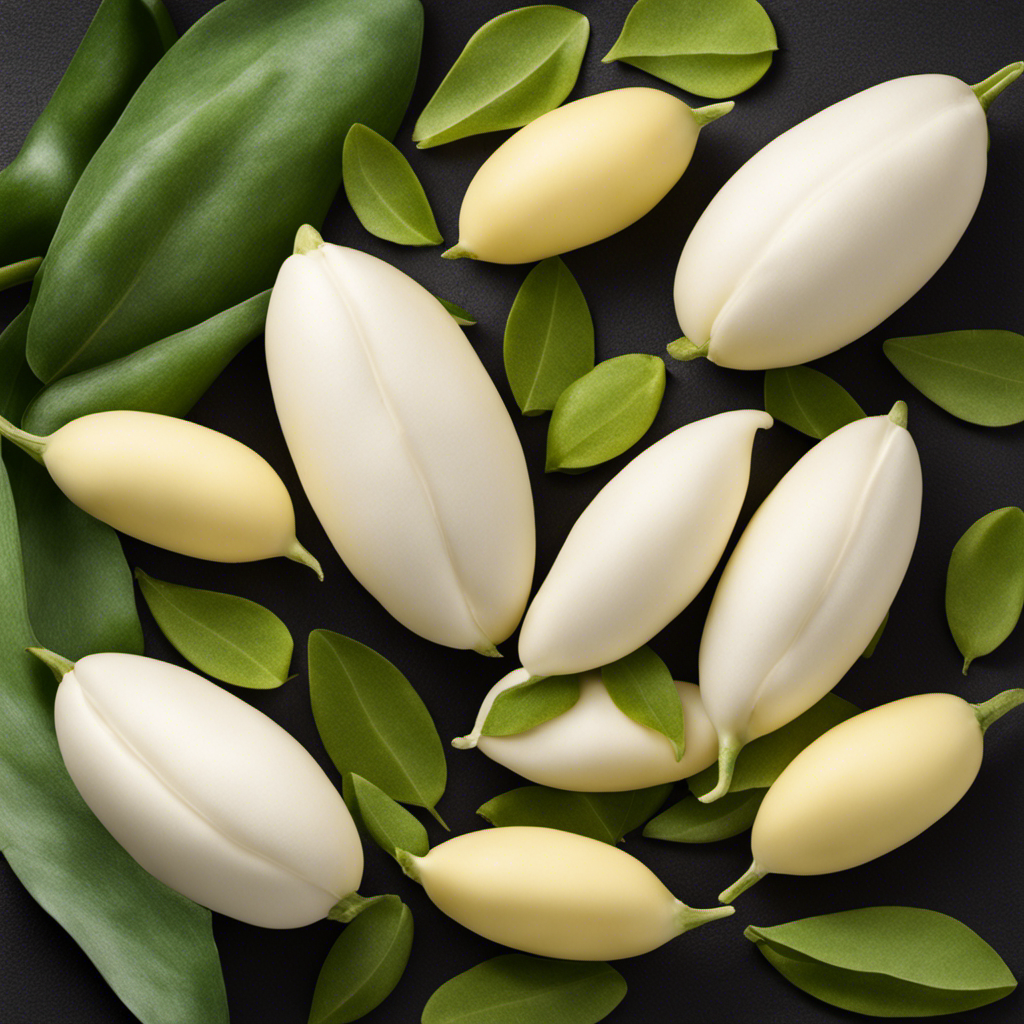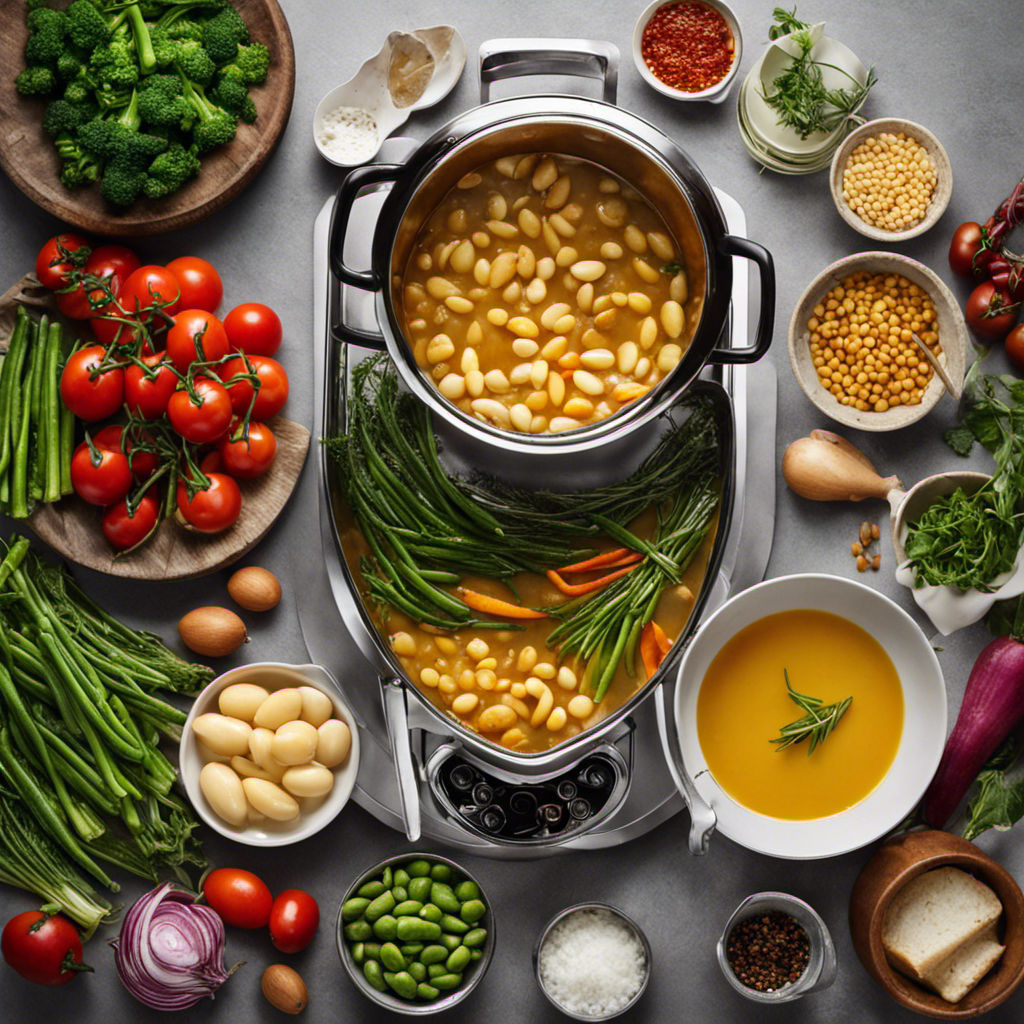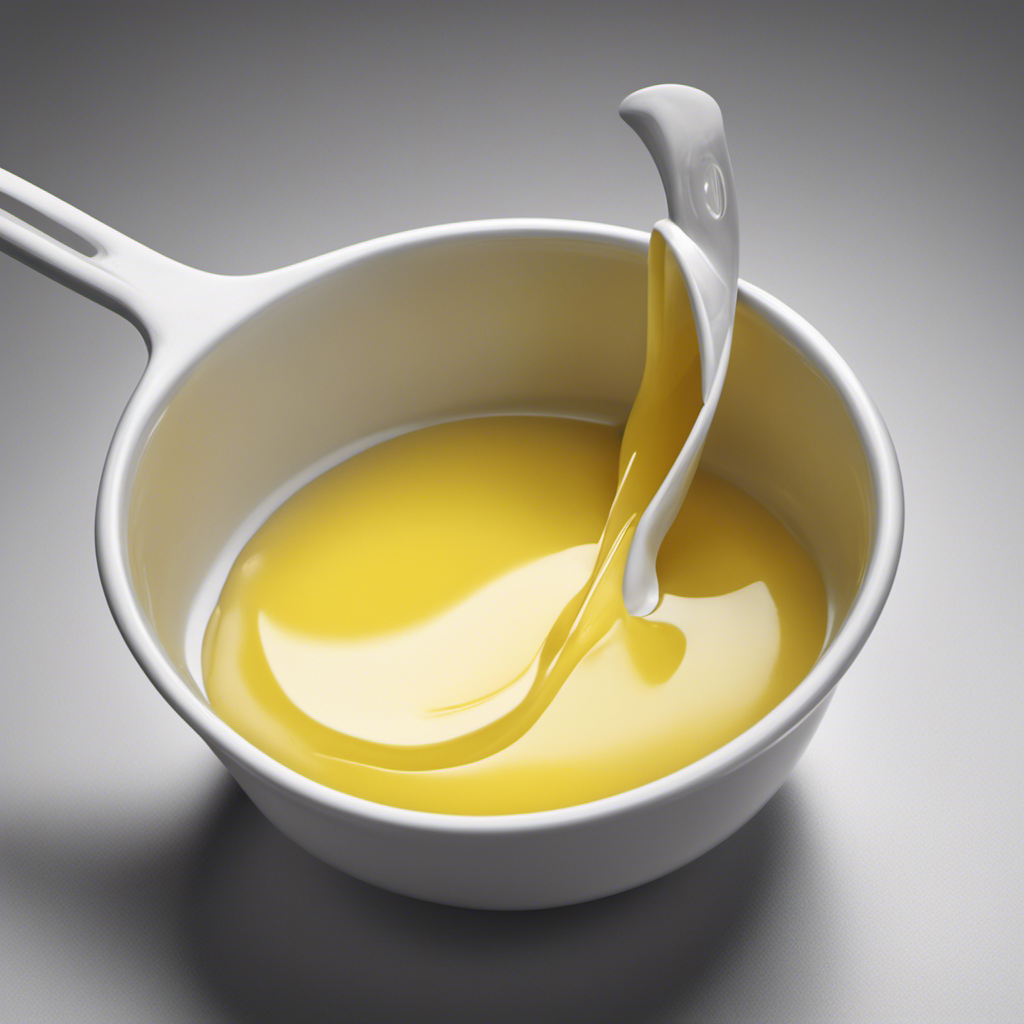As a baking enthusiast, I have frequently pondered, “What temperature is considered room temperature for butter?” This is an essential question to address in order to achieve the ideal texture and consistency in our recipes.
In this article, I’ll delve into the concept of room temperature butter, exploring the factors that affect its temperature and the ideal range we should aim for.
Additionally, I’ll share quick tips for softening butter efficiently and discuss how to store it at room temperature.
Get ready to elevate your baking game with this essential knowledge.
Key Takeaways
- Room temperature butter is typically around 70 degrees Fahrenheit.
- The ideal temperature range for room temperature butter is 65-75 degrees Fahrenheit.
- External temperature influences the state of butter.
- Keeping butter at a consistent temperature between 60-68°F (15-20°C) maintains desired texture and flavor.
Understanding the Concept of Room Temperature Butter
Room temperature butter is typically around 70 degrees Fahrenheit.
It is important to understand the concept of room temperature butter, as it plays a crucial role in various baking and cooking recipes.
One key aspect to consider is the butter’s melting point, which is around 90-95 degrees Fahrenheit. This means that at temperatures below its melting point, butter will be solid and firm, making it difficult to spread or incorporate into recipes.
On the other hand, at temperatures above its melting point, butter will become a liquid, which can affect the texture and structure of baked goods.
Therefore, the ideal temperature range for room temperature butter is between 65-75 degrees Fahrenheit, allowing it to be soft and pliable, making it easier to work with in the kitchen.
Factors That Affect the Temperature of Butter
When it comes to the temperature of butter, there are several factors that come into play.
Firstly, external temperature influences can have a significant impact on the overall temperature of butter.
Additionally, the heat conductivity of butter plays a role in how quickly it can be affected by its surroundings.
Lastly, storage conditions, such as the temperature and humidity of the environment, can also impact the temperature of butter over time.
External Temperature Influences
You can tell if the external temperature is influencing your butter by its softness. External temperature fluctuations play a crucial role in determining the state of your butter. Here are some key points to consider:
- Butter has a melting point of around 90°F (32°C).
- If the external temperature rises above the butter’s melting point, it will become softer and may even start to melt.
- Conversely, if the external temperature drops below the butter’s melting point, it will harden and become more solid.
- Rapid temperature changes can cause the butter to go through a process called ‘fat bloom,’ resulting in a grainy texture.
- Keeping butter at a consistent temperature, ideally between 60-68°F (15-20°C), can help maintain its desired texture and flavor.
Butter’s Heat Conductivity
To better understand how butter behaves when heated, it’s important to consider its heat conductivity. Heat conductivity refers to the ability of a material to conduct heat. In the case of butter, its heat conductivity is relatively low compared to other substances. This means that butter takes longer to heat up and also retains heat for a longer period of time. The melting point of butter is around 32-35 degrees Celsius (90-95 degrees Fahrenheit), which is relatively low compared to other fats. This low melting point is due to the high content of milk solids and water in butter. When heated, the fat molecules in butter start to break down and separate from the other components. This process contributes to the delicious flavor and texture that butter brings to our cooking and baking.
| Property | Value |
|---|---|
| Heat Conductivity | Low |
| Melting Point | 32-35°C (90-95°F) |
Storage Conditions’ Impact
The impact of storage conditions on butter’s quality and shelf life can be significant. Proper butter storage methods are crucial in maintaining its freshness and taste. The effects of room temperature on butter quality are particularly important to consider. Here are five key points to keep in mind:
-
Temperature: Butter should be stored in a cool place, ideally between 32-40°F (0-4°C).
-
Air exposure: Butter should be tightly wrapped to prevent exposure to air, which can cause oxidation and off-flavors.
-
Odor absorption: Butter easily absorbs odors, so it should be stored away from strong-smelling foods.
-
Moisture control: Excess moisture can lead to spoilage and rancidity, so butter should be stored in a dry environment.
-
Freezer storage: If you won’t be using butter within a few weeks, it can be safely stored in the freezer for up to six months.
The Ideal Temperature for Room Temperature Butter
Remember, the ideal temperature for room temperature butter is around 68 to 70 degrees Fahrenheit. This temperature range allows the butter to be soft and spreadable without being too melted or too firm. Achieving the ideal butter temperature is crucial for successful baking and cooking.
There are a few methods you can use to soften butter to the ideal temperature. One common method is to simply leave it out on the counter for 30 minutes to an hour, depending on the temperature of your kitchen. Another method is to use a microwave on the defrost setting, checking and rotating the butter every 10-15 seconds to ensure it softens evenly. Additionally, you can grate the butter or pound it with a rolling pin to speed up the softening process.
Transitioning into the next section, let’s explore how to soften butter quickly when you’re short on time.
How to Soften Butter Quickly
If you’re in a hurry, there are a few ways to quickly soften butter for your baking or cooking needs. Here are some quick butter softening methods to consider:
-
Microwave Method: Cut your butter into small, evenly-sized pieces and place them in a microwave-safe bowl. Heat the butter in short intervals, checking and stirring in between to ensure even melting.
-
Grating Method: Take a cold stick of butter and grate it using a box grater. This increases the surface area, allowing it to soften more quickly.
-
Warm Water Method: Fill a glass or bowl with warm water and let it sit for a minute to warm up. Pour out the water and place the glass or bowl upside down over your butter. The residual heat will help soften it.
-
Rolling Pin Method: Place your cold butter between two sheets of parchment paper and use a rolling pin to gently roll it out. This will soften the butter while maintaining its shape.
-
Sous Vide Method: Place your wrapped butter in a sealed bag and immerse it in warm water (around 110°F) for a few minutes. This controlled temperature will soften the butter without melting it.
Using any of these quick butter softening methods will save you time when you need softened butter for your recipes. However, it’s important to note that some baking recipes specifically call for room temperature butter. So, let’s explore the benefits and techniques of using room temperature butter in baking recipes.
Using Room Temperature Butter in Baking Recipes
Now that we know how to quickly soften butter, let’s explore the benefits of using room temperature butter in baking recipes.
Room temperature butter refers to butter that has been left out at a stable temperature, typically around 68 to 72 degrees Fahrenheit (20 to 22 degrees Celsius). This temperature allows the butter to soften, but not melt.
Using room temperature butter in baking has several advantages. Firstly, it blends more easily with other ingredients, resulting in a smoother and more homogenous batter or dough. Secondly, room temperature butter incorporates more air when beaten, leading to a lighter texture in baked goods. Lastly, it allows for better emulsification of ingredients, resulting in a more even distribution of fats and flavors throughout the final product.
Transitioning to the next section, for those who are concerned about the safety of leaving butter at room temperature, there are tips and guidelines for storing butter safely.
Tips for Storing Butter at Room Temperature
One way to ensure the safety of your butter when storing it at room temperature is by using a butter dish with a lid. This not only keeps the butter fresh, but also protects it from external contaminants.
However, if you prefer to store your butter in the fridge or if you live in a hot climate where room temperature butter may spoil quickly, there are alternative options available. Consider these alternatives for room temperature butter storage:
- Butter Bell: A traditional French butter crock that keeps butter fresh and spreadable for up to a month.
- Butter Keeper: Similar to a Butter Bell, it keeps butter fresh and easily accessible without refrigeration.
- Butter Dish with Water: Place a small amount of water in a butter dish and store the butter on top of it to maintain a cool temperature.
- Butter Tray with Lid: A container specifically designed to store butter at room temperature while keeping it safe and fresh.
- Butter Wrappers: Store individual portions of butter in wax or parchment paper and freeze them, allowing you to use room temperature butter whenever needed.
Troubleshooting Common Issues With Room Temperature Butter
To troubleshoot common issues with storing butter at room temperature, you may want to check if the butter dish is properly sealed to prevent exposure to air. This can help maintain the consistency of the butter and prevent it from melting too quickly.
When butter is exposed to air, it can become soft and lose its shape, making it difficult to spread or use in recipes. A properly sealed butter dish will create a barrier that prevents air from reaching the butter, helping it maintain its desired consistency.
Additionally, it is important to store the butter in a cool area away from direct sunlight or heat sources, as this can also cause it to melt quickly.
Alternatives to Room Temperature Butter in Recipes
If you’re looking for alternatives in recipes, you can use softened margarine or coconut oil as a substitute for room temperature butter. Here are some key points to consider when using these butter substitutes:
-
Softened margarine: Made from vegetable oils, margarine is a popular choice for baking and cooking. It has a similar consistency to room temperature butter and can be easily incorporated into recipes.
-
Coconut oil: This plant-based oil is a great option for vegan recipes. It adds a subtle coconut flavor and works well in both sweet and savory dishes.
-
Consider the texture: When substituting butter, it’s important to consider the texture it provides to the recipe. Softened margarine and coconut oil can help maintain the moisture and richness that butter adds.
-
Adjustments may be needed: Keep in mind that the flavor and texture may differ slightly when using butter substitutes. Experimenting with different ratios and adjustments may be necessary to achieve the desired results.
-
Allergies and dietary restrictions: Butter substitutes are a great option for those with dairy allergies or following a vegan diet, allowing them to enjoy a wide range of recipes without compromising taste or texture.
Overall, using softened margarine or coconut oil as a substitute for room temperature butter can provide tasty alternatives in a variety of recipes, especially in vegan dishes.
Frequently Asked Questions
Can I Use Melted Butter as a Substitute for Room Temperature Butter in Baking Recipes?
Yes, you can use melted butter as a substitute for room temperature butter in baking recipes. However, it may affect the texture of the baked goods. Alternatives to room temperature butter include using softened butter or oil.
What Is the Difference Between Room Temperature Butter and Softened Butter?
Room temperature butter is preferred in baking recipes because it blends easily with other ingredients, resulting in a smoother texture. Unlike cold butter, it softens quickly at room temperature, making it easier to incorporate into the batter.
Can I Use Cold Butter Instead of Room Temperature Butter in Baking Recipes?
Using room temperature butter in baking recipes has benefits, like easier incorporation with other ingredients and better texture. To properly soften cold butter, leave it at room temperature for about 30 minutes or use a microwave at low power.
How Long Does It Take for Butter to Reach Room Temperature?
Room temperature butter is ideal for baking because it incorporates more air, resulting in lighter and fluffier baked goods. To store butter at room temperature, keep it in a covered dish or butter dish.
Can I Microwave Butter to Quickly Soften It for Baking?
Yes, you can microwave butter to quickly soften it for baking. However, be cautious and use short intervals, as microwaving can cause uneven heating. Alternatively, you can try other methods like grating or pounding the butter.
Conclusion
In conclusion, understanding the concept of room temperature butter is crucial for successful baking. By knowing the factors that affect its temperature and the ideal temperature for room temperature butter, you can ensure that your recipes turn out perfectly.
If you need to soften butter quickly, there are effective methods to do so. Additionally, storing butter at room temperature requires proper precautions to avoid spoilage.
Lastly, if you encounter any issues with room temperature butter, troubleshooting techniques can help. Remember, there are alternatives available if room temperature butter is not suitable for your recipes.










